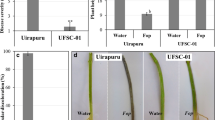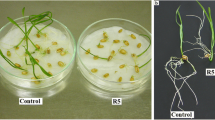Abstract
The structural defense response of a black pepper line (04-P24) showing root resistance to Phytophthora capsici was studied in comparison with a highly susceptible line (Sreekara). Role of cell wall reinforcement and cell membrane integrity was analyzed. Cell membrane integrity was studied under hydroponic system in terms of leakage of electrolytes caused by the cell membrane damage due to pathogen entry. Root cell membrane rupture and resultant phenolic leakage were clearly visible in the form of color change of the liquid phase during the course of infection. Root leachates of Sreekara turned highly dark due to the increased level of phenol leakage which was proportional to the cell membrane damage. The root leachate was analyzed for change in conductivity, total phenols and ortho-dihydroxy (OD) phenols. Cell wall reinforcement of the vascular tissues of black pepper root upon pathogen inoculation was analyzed histochemically. Toluidine blue O and Maule staining differentiated the intensity of lignin deposition in the root cells of both lines and it was comparatively stronger in the resistant line. Scanning electron microscopy revealed that hyphae of P. capsici are not penetrating the root of 04-P24 supporting the finding that roots of this line don’t support Phytophthora infection.













Similar content being viewed by others
References
Asselbergh, B., Curvers, K., França, S. C., Audenaert, K., Vuylsteke, M., Van Breusegem, F., & Höfte, M. (2007). Resistance to Botrytis cinerea in sitiens, an abscisic acid-deficient tomato mutant, involves timely production of hydrogen peroxide and cell wall modifications in the epidermis. Plant Physiology, 144(4), 1863–1877.
Bais, H. P., Vepachedu, R., Gilroy, S., Callaway, R. M., & Vivanco, J. M. (2003). Allelopathy and exotic plant invasion: From molecules and genes to species interactions. Science, 301(5638), 1377–1380.
Bais, H. P., Park, S. W., Weir, T. L., Callaway, R. M., & Vivanco, J. M. (2004). How plants communicate using the underground information superhighway. Trends in Plant Science, 9(1), 26–32.
Belanger, R. R., & Bushnell, W. R. (2002). The powdery mildews: A Comprehensive treatise. St. Paul: APS Press.
Benhamou, N., & Bélanger, R. R. (1998). Induction of systemic resistance to Pythium damping-off in cucumber plants by benzothiadiazole: Ultrastructure and cytochemistry of the host response. The Plant Journal, 14(1), 13–21.
Bertin, C., Yang, X., & Weston, L. A. (2003). The role of root exudates and allelochemicals in the rhizosphere. Plant and Soil, 256(1), 67–83.
Bhai, R. S., Eapen, S. J., Anandaraj, M., & Saji, K. V. (2010). Identification of Phytophthora and nematode-resistant source-from opens pollinated progenies of black pepper (Piper nigrum) using a modified protocol. Indian Journal of Agricultural Science, 80(10), 893–897.
Bishop, D. L., Chatterton, N. J., Harrison, P. A., & Hatfield, R. D. (2002). Changes in carbohydrate coordinated partitioning and cell wall remodeling with stress-induced pathogenesis in wheat sheaths. Physiological and Molecular Plant Pathology, 61(1), 53–63.
Buonaurio, R. (2008). Infection and plant defense responses during plant-bacterial interaction. Plant-Microbe Interactions, 169–197.
Cesco, S., Neumann, G., Tomasi, N., Pinton, R., & Weisskopf, L. (2010). Release of plant-borne flavonoids into the rhizosphere and their role in plant nutrition. Plant and Soil, 329(1–2), 1–25.
Curvers, K., Seifi, H., Mouille, G., De Rycke, R., Asselbergh, B., Van Hecke, A., Vanderschaeghe, D., Höfte, H., Callewaert, N., van Breusegem, F., & Höfte, M. (2010). Abscisic acid deficiency causes changes in cuticle permeability and pectin composition that influence tomato resistance to Botrytis cinerea. Plant Physiology, 154(2), 847–860.
De Waard, P. W. F. (1986). Current state and prospective trends of black pepper (Piper nigrum L.) production. Outlook on Agriculture, 15(4), 186–195.
Dixon, R. A. (2001). Natural products and plant disease resistance. Nature, 411(6839), 843–847.
Egea, C., Ahmed, A. S., Candela, M., & Candela, M. E. (2001). Elicitation of peroxidase activity and lignin biosynthesis in pepper suspension cells by Phytophthora capsici. Journal of Plant Physiology, 158(2), 151–158.
Eltahir, A. S., & AbuReish, B. I. (2010). Comparative morphological and anatomical studies of the barks of three Albizzia species. Journal of Chemical and Pharmaceutical Research, 2(3), 260–268.
Enstone, D. E., Peterson, C. A., & Ma, F. (2002). Root endodermis and exodermis: Structure, function, and responses to the environment. Journal of Plant Growth Regulation, 21(4), 335–351.
Eynck, C., Koopmann, B., Karlovsky, P., & Von Tiedemann, A. (2009). Internal resistance in winter oilseed rape inhibits systemic spread of the vascular pathogen Verticillium longisporum. Phytopathology, 99(7), 802–811.
Faulkner, G., & Kimmins, W. C. (1975). Staining reactions of the tissue bordering lesions induced by wounding, tobacco mosaic virus, and tobacco necrosis virus in bean. Phytopathology, 65(12), 1396–1400.
Griffin, M. J. (1977). Cocoa Phytophthora workshop, Rothamsted Experimental Station, England, 24–26 may 1976. PANS, 23(1), 107–110.
Guest, D., & Brown, J. (1997). Plant defense against pathogens. In J. F. Brown & H. J. Ogle (Eds.), Plant pathogens and plant diseases, Rockvale publications (pp. 263–286). Australia: Armidale NSW 2350.
Gutfinger, T. (1981). Polyphenols in olive oils. Journal of the American Oil Chemists Society, 58(11), 966–968.
Heath, M. C. (2000). Hypersensitive response-related death. Plant Molecular Biology, 44, 321–334.
Hoagland, D.R., & Arnon, D.I., 1950. The water-culture method for growing plants without soil. Circ. 347. Univ. of Calif. Agric. Exp. Station, Berkley.
Huitema, E., Bos, J. I., Tian, M., Win, J., Waugh, M. E., & Kamoun, S. (2004). Linking sequence to phenotype in Phytophthora–plant interactions. Trends in Microbiology, 12(4), 193–200.
Jackson, K. M., & Ilamurugu, K. (2014). Metabolic profiling of rice root exudates and its impact on rhizosphere microbial dynamics under aerobic conditions. Research Journal of Agricultural Sciences, 5(4), 777–781.
Johansen, D. A. (1940). Plant microtechnique (pp. 27–154). New York: McGraw Hill.
Jones, J. D., & Dangl, J. L. (2006). The plant immune system. Nature, 444(7117), 323–329.
Lanoue, A., Burlat, V., Henkes, G. J., Koch, I., Schurr, U., & Röse, U. S. (2010). De novo biosynthesis of defense root exudates in response to Fusarium attack in barley. New Phytologist, 185(2), 577–588.
Li, X. G., Zhang, T. L., Wang, X. X., Hua, K., Zhao, L., & Han, Z. M. (2013). The composition of root exudates from two different resistant peanut cultivars and their effects on the growth of soil-borne pathogen. International Journal of Boilogical Science, 9(2), 164–173.
Lipka, V., Dittgen, J., Bednarek, P., Bhat, R., Wiermer, M., Stein, M., Landtag, J., Brandt, W., Rosahl, S., Scheel, D., & Llorente, F. (2005). Pre-and postinvasion defenses both contribute to nonhost resistance in Arabidopsis. Science, 310(5751), 1180–1183.
Menden, B., Kohlhoff, M., & Moerschbacher, B. M. (2007). Wheat cells accumulate a syringyl-rich lignin during the hypersensitive resistance response. Phytochemistry, 68(4), 513–520.
Nicholson, R. L., & Hammerschmidt, R. (1992). Phenolic compounds and their role in disease resistance. Annual Review of Phytopathology, 30(1), 369–389.
O'brien, T. P., Feder, N., & McCully, M. E. (1964). Polychromatic staining of plant cell walls by toluidine blue O. Protoplasma, 59(2), 368–373.
Oliver, J. P., Castro, A., Gaggero, C., Cascón, T., Schmelz, E. A., Castresana, C., & De León, I. P. (2009). Pythium infection activates conserved plant defense responses in mosses. Planta, 230(3), 569–579.
Pearce, R. B., & Rutherford, J. (1981). A wound-associated suberized barrier to the spread of decay in the sapwood of oak (Quercus robur L.). Physiological Plant Pathology, 19(3), 359IN26–369IN31.
Pellizzari, E. D., Kuc, J., & Williams, E. B. (1970). The hypersensitive reaction in Malus species: Changes in the leakage of electrolytes from apple leaves after inoculation with Venturia inaequalis. Phytopathology, 60, 373–376.
Ramírez, V., Agorio, A., Coego, A., García-Andrade, J., Hernández, M. J., Balaguer, B., Ouwerkerk, P. B., Zarra, I., & Vera, P. (2011). MYB46 modulates disease susceptibility to Botrytis cinerea in Arabidopsis. Plant Physiology, 155(4), 1920–1935.
Romero, D., Rivera, M. E., Cazorla, F. M., Codina, J. C., Fernández-Ortuño, D., Torés, J. A., Pérez-García., A., & de Vicente, A. (2008). Comparative histochemical analyses of oxidative burst and cell wall reinforcement in compatible and incompatible melon–powdery mildew (Podosphaera fusca) interactions. Journal of Plant Physiology, 165(18), 1895–1905.
Shi, H., Liu, Z., Zhu, L., Zhang, C., Chen, Y., Zhou, Y., Li, F., & Li, X. (2012). Overexpression of cotton (Gossypium hirsutum) dirigent1 gene enhances lignification that blocks the spread of Verticillium dahliae. Acta Biochimica et Biophysica Sinica, 44(7), 555–564.
Singh, A. (2006). Cell membrane injury in flag leaf of wheat by brown rust (Puccinia recondita rob. Ex. Desm. f. Sp. tritici) at different nitrogen levels. Journal of Phytological Research, 19(1), 111–113.
Thankamani, C. K. (2008). Black pepper. In V. A. Parthasarathy, K. Kandiannan, & V. Srinivasan (Eds.), Organic spices (p. 250). New Delhi: New India Publishing Agency.
Trivedi, M., & Singh, A. (2014). Cell membrane injury in barley (Hordeum vulgare L.) associated with infection by Drechslera graminea, stripe disease. International Journal of Scientific & Technology Research, 3(2), 320–323.
Uren, N. C. (2000). Types, amounts and possible functions of compounds released into the rhizosphere by soil grown plants. In R. Pinton, Z. Varanini, & P. Nannipieri (Eds.), The Rhizosphere: Biochemistry and organic substances at the soil interface (pp. 19–40). New York: Marcel Dekker.
van Kan, J. A. (2006). Licensed to kill: The lifestyle of a necrotrophic plant pathogen. Trends in Plant Science, 11(5), 247–253.
Vandana, V. V., Bhai, R. S., & Shamina, A. (2014). Biochemical defense responses of black pepper (Piper nigrum L.) lines to Phytophthora capsici. Physiological and Molecular Plant Pathology, 88, 18–27.
Vuković, R., Bauer, N., & Ćurković-Perica, M. (2013). Genetic elicitation by inducible expression of β-cryptogein stimulates secretion of phenolics from Coleus blumei hairy roots. Plant Science, 199, 18–28.
Wang, G., Lin, Q., & Xu, Y. (2007). Tetraena mongolica maxim can accumulate large amounts of triacylglycerol in phloem cells and xylem parenchyma of stems. Phytochemistry, 68(15), 2112–2117.
Wang, P., Liu, X., Guo, J., Liu, C., Fu, N., & Shen, H. (2015). Identification and expression analysis of candidate genes associated with defense responses to Phytophthora capsici in pepper line “PI 201234”. International Journal of Molecular Sciences, 16(5), 11417–11438.
Wurst, S., Wagenaar, R., Biere, A., & Van der Putten, W. H. (2010). Microorganisms and nematodes increase levels of secondary metabolites in roots and root exudates of Plantago lanceolata. Plant and Soil, 329(1–2), 117–126.
Acknowledgements
This research was funded by the Kerala State Council for Science, Technology and Environment (KSCSTE), Council Order No. (T)364/FSHP/2010/CSTE, Thiruvananthapuram, Kerala, India. Authors acknowledge Director, ICAR-IISR, Kozhikode, Kerala, India for facilities provided. The authors gratefully acknowledge the Director, National Institute of Technology, Kozhikode for providing the SEM facility.
Author information
Authors and Affiliations
Corresponding author
Ethics declarations
Ethical statement
This research article is not submitted elsewhere for publication and this manuscript complies to the Ethical Rules applicable for this journal.
Additional information
Highlights
1. The study was carried out in Phytophthora capsici susceptible (Sreekara) and resistant (04-P24, shows root resistance to the pathogen) black pepper lines.
2. The role of cell membrane integrity and cell wall reinforcement in imparting resistance to P. capsici was studied and found that increased cell membrane integrity and higher lignification of root cells (mainly vascular tissues) play crucial role in root resistance of 04-P24 to P. capsici.
3. In our previous paper published in the journal PMPP (Vandana et al., 2014), the role of lignin in root resistance of 04-P24 was clearly described. The results obtained in this study confirm the above finding.
Rights and permissions
About this article
Cite this article
Vandana, V.V., Suseela Bhai, R., Ramakrishnan Nair, R. et al. Role of cell wall and cell membrane integrity in imparting defense response against Phytophthora capsici in black pepper (Piper nigrum L.). Eur J Plant Pathol 154, 359–375 (2019). https://doi.org/10.1007/s10658-018-01661-3
Accepted:
Published:
Issue Date:
DOI: https://doi.org/10.1007/s10658-018-01661-3




